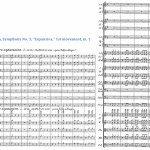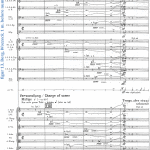In one of the books published by Robert Craft in collaboration with Igor Stravinsky (Conversations with Stravinsky, 1959), Craft entices Stravinsky into playing a parlor game. Following the widespread notion that Schoenberg and Stravinsky represent quintessential musical antipodes in the 20th century – a view that forms the very backbone of philosopher Theodor W. Adorno’s influential Philosophy of Modern Music (1949, English edition in 1973) – Stravinsky puts words in Schoenberg’s mouth and positions himself in relation to a number of imagined statements. The last of these statement is: “A Chinese philosopher speaks Chinese, but what does he say?” Stravinsky answers: “What the Chinese philosopher says cannot be separated from the fact that he says it in Chinese.”
The relationship between what is said and how it is said is a recurring issue in aesthetics. In a broader sense, it is about the relationship between content and method, between the features of a work and the way they have been designed. This divide goes all the way back to Aristotle, and in Roman philosophy the divide between res (substance) and verba (expression) anticipates what is nowadays commonly referred to as content (what is said) and form (the way it is said).
This is a fundamental divide in the discourse pertaining to all the arts, but it becomes particularly apparent in the area of orchestration. History abounds with examples that point to a distinction between instrumentation and the music “in itself” (per se). Danish composer Carl Nielsen, for example, seems to have regarded orchestration mainly as a discipline based on technical skill, the craft of “arranging” the music for orchestra, something basically independent of the creative process (Nielsen is known to have received frequent help from his students when this activity struck him to be nothing but time-consuming routine work).
Distinguishing between instrumentation and the music “in itself” has always been a matter of debate. While some composers find this to be a natural division, others regard it as an unfounded categorization, a nonsensical distinction. And contrary to what one may think, it is not primarily a question of working methods. Some compose the music first and orchestrate later. For others, the two are so closely linked that they emerge simultaneously; and for some composers, orchestral considerations strongly affect compositional choices and the character of the resulting music.
The problem is more far-reaching than the old question about what came first, the chicken or the egg. Quite a few composers sketch out their orchestral music in a so-called “short score,” indicating only certain instruments and details of orchestration. Gustav Mahler typically used a short score with six staffs when – free from conducting obligations during the summer months – sketching out his symphonies. Maurice Ravel frequently composed his music for piano prior to orchestrating it, a fact that not only applies to works that were initially conceived for the piano.
Conversely, the work of other composers such as Richard Strauss and Stravinsky shows that the choice of certain instruments often decisively impacts the musical diction itself, that it actually “engenders” the music – the instrument is conceived before, not after the music, so to speak (think, for example, of the famous solo for double bassoon in Salome, or the bassoon solo in the opening measures of Le sacre du printemps).
In such cases, the relationship between what is said and how it is said evokes classical opposites: body and soul, inner and outer, essence and appearance, among which the latter seems particularly apt. For just as it is evident that no music is ever identical with its orchestration (surely quite a few details in the orchestration of a piece of music can be changed without causing the music “in itself” to fundamentally change), it is equally evident that only through the appearance of something, be it music, people or something else, can we gain access to its essence. Music is not synonymous with its appearance. In fact, it may not be a matter of appearances at all, yet the outer manifestation of any thing or phenomenon will inevitably influence our perception of its inner qualities. Speaking about body and soul as if they were isolated phenomena leads to contradictions and philosophical quicksand. The fact that music is never mere appearance does not alter the fact that its appearance strongly affects the listener’s perception of what indeed it “is.”
An area representing a succinct example of the divide between music “in itself” and the way it is clothed is the long tradition of orchestral music adapted for the piano, so-called piano reductions. Here, different approaches can easily be observed. Choosing as a random example the orchestral part of Mozart’s piano concertos, a wealth of different piano versions exists. At first one might expect that a piano reduction of Mozart’s orchestra would appear similar to Mozart’s own piano music. This may occasionally be the case. Quite frequently, however, such reductions emerge as heavy, rather clumsy piano adaptations whose intention is to transfer as many orchestral elements as possible, rather than to target an idiomatic Mozartian piano style.
Figure 7-8 · Mozart, Piano Concerto, K. 482, 2nd. movement, m 64 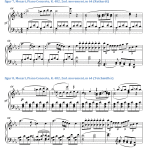
Similarly, a comparison between different piano scores of one of the more complex romantic operas is likely to show immense differences, as any attempt to represent all the elements and parts in a playable reduction for piano is usually futile. The result might range from an objective effort to focus as faithfully as possible on the main elements of the original score, to a piano style reminiscent of virtuoso piano music from the Romantic era. Again, the goal is crucial: is the piano score intended for use during opera rehearsals – a practical tool to memorize and rehearse music and staging without having to rely on a hydra-headed monster of an orchestra with its forbidding costs? Or is it to create an idiomatic piano version, artistically commensurate with the original orchestral score?
Here is a section from Wagner’s Tristan und Isolde in three different piano reductions:
Figure 9 · Wagner, Tristan und Isolde, 2nd Act, Scene 2 (Kleinmichel) 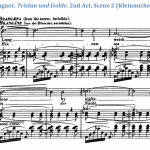
Figure 10 · Wagner, Tristan und Isolde, 2nd Act, Scene 2 (Motl und Kogel) 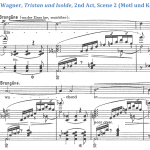
Figure 11 · Wagner, Tristan und Isolde, 2nd Act, Scene 2 (Bülow) 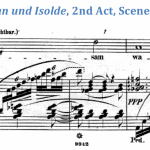
Such examples of the complex relationship between “what?” and “how?” do in fact demonstrate the problems inherent in the common view that the notes themselves always have a certain priority, as exhibited by the relationship between Paganini and Liszt (Idiomatic Practice · figs. 1-4). Few would ever consider changing a single note in a sonata by Beethoven. Yet many interpreters – Glenn Gould is an extreme case – take a rather free approach to tempo and expression markings, dynamics, phrasing and other instructions in the musical text.
One may ask whether the notes as such really deserve the staunch priority they usually are given. As mentioned earlier, Liszt’s intent was not really to transfer Paganini’s notated pitches and rhythms – the appearance of the music – to the piano, but to transfer their essence, i.e. Paganini’s instrumental way of thinking, his idiomatic approach, rather than the musical text. It is the same problem faced by the translator: a direct, word-to-word translation from one language to another will often distort rather than clarify.
Orchestral music seems to highlight the relationship between essence and appearance more than any other musical medium. This is because an orchestra – compared to single instruments or chamber music – dramatically extends the ways in which something can be said, a fact that leads to the following fundamental question: does this relationship seem natural and consequential in a specific situation, or may there be a mismatch, a disparity, a situation in which the appearance of the music could possibly distort, obscure or even obstruct the genuine perception of musical essence?
From a more technical, less philosophical standpoint, this divide may be described as the relationship between intent and realization in music for orchestra. Given that the word “intent” is not devoid of philosophical connotations, as the composer’s intent can rarely be ascertained unambiguously, we need to take a closer look at the term. The word “intent” must here be understood in its broadest sense: evaluating what the composer wanted to realize in a given score, based exclusively on the existing musical data. Thus the term should be considered a practical or analytical tool, not a well-defined, clearly delineated concept. A few examples will clarify the matter:
Figure 12 · Nielsen, Symphony No. 3, “Espansiva,” 1st movement, m. 1
This powerful, innovative opening with its driving rhythmic intensification of a single note doubled in octaves for full orchestra clearly “points to” what immediately follows: the symphony’s main theme played by the woodwinds. But in practice, the upbeat intended to be highlighted by this intensification is drowned out by too much resonance. It may seem surprising that Nielsen, after such a noisy and heavy tutti, chose to limit the presentation of the main theme to the relatively “weak” woodwinds. The likely explanation – apart from the wish to provide a contrast in tone color – is the fact that Nielsen’s orchestral thinking frequently gives more weight to contrapuntal considerations rather than to idiomatic orchestration: horns and strings enter a bit later with a counterpoint and a continuation of the melody, respectively.
This example is by no means intended to discredit Nielsen, but to illustrate a somewhat unfortunate relationship between intent and realization, and to show that the problem arises from the clash between two different strands of musical thought. The reason why it is practically impossible to improve upon or “correct” this passage may lie precisely in the fact that it represents a clash of intentions – no change in the orchestration could possibly solve the problem without profoundly changing the music itself[1].
Figure 13 · Berg, Wozzeck, 1 m. before number 110
Audio 13a · Audio 13b · Audio 13c
It is evident that Berg, at the culmination of this highly dramatic scene in the opera’s 3rd act, intends to create an orchestral crescendo on a single note (B natural) by letting the instruments enter one by one, from softest to loudest. Berg aims for an unobtrusive, gradual increase in volume and sound, and his care in this respect is apparent. At one point, however, he fails: when the oboes enter, they protrude and become clearly audible. The reason is simple: the low B cannot be played softly or unobtrusively on an oboe, and Berg calls for no less than four oboes playing the note simultaneously – an oversight on his part, no doubt. The problem is solved easily without having to tamper with Berg’s scoring: if only one oboe enters as written, and the other three wait for a tiny moment to enter in turn, the crescendo works flawlessly[2].
These two examples serve to illuminate the need for investigating the relationship between intent and realization. As can be seen, this may provide a rare possibility for an artistic and/or aesthetic evaluation based on objective criteria: if one acknowledges the intentions of Nielsen and Berg in the above excerpts to be unquestionable, it follows that these intentions are not adequately realized. This may in turn indicate that an analysis of the composer’s intent deserves a special status in music theory. Whereas traditional musical analysis must content itself with unveiling visual or aural connections, largely without any simple way to determine if – or to what extent – they represent conscious intentions on the composer’s part, intention analysis in the field of instrumentation allows us to examine and verify the composer’s objective with near certainty. The score thus opens itself to critical evaluation in a way that rises above the usual lack of common aesthetic criteria. General questions such as this will not be elaborated upon any further within the confines of this book. But as a functional model for qualitative assessments in the field of aesthetics, the workability of analyzing the composer’s intentions may at least have been made plausible.
· · ·
Next · Chapter 2 · Translation, Clarification, Amplification
· · ·
[1]In practice, reasonably satisfying results can be obtained by introducing the main theme slightly later than written, as evidenced by several recent recordings of the work.
[2]Also the orchestra’s other double reed instrument, the bassoon, has difficulty producing its lowest tones at soft dynamics. For the descending bassoon solo 11 measures before letter H in Tchaikovsky’s Pathétique, the composer prescribes pppppp (!), but today the bassoon is usually replaced by a bass clarinet. Similarly, the double bass clarinet has greater flexibility in the lowest register than the double bassoon, but is not a permanent member of the symphony orchestra (and lacks the four lowest notes of the double bassoon). The very lowest notes of the bassoon can be played more softly by a double bassoon (written an octave higher), but at the expense of the bassoon’s greater intensity of sound.
